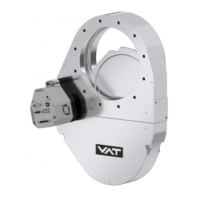Series 65 DESIGN AND FUNCTION
963283EA Edition 2019-05-03 17/
3.2.1.1 Way of operation
The controller compares the actual pressure in the process chamber given by the pressure sensor
with the preset pressure. The controller uses the difference between actual and set pressure to
calculate the correct position of the control valve. The controller drives the control valve into the
correct position and the actual pressure again equals the set pressure.
This control operation is performed continuously. Pressure changes in the process chamber due to
leaks, desorption, and gas flow, reaction products, variations in pumping speed etc. are always
corrected at once.
3.2.1.2 Pressure control
In a vacuum system which is pumped and into which gas is admitted at the same time, the pressure
can be controlled in two ways:
1. Downstream control (standard):
The pressure is controlled by changing the conductance of a control valve between pump and
process chamber. This changes the effective pumping speed at the process chamber. Pressure
and gas flow can be independently controlled over a wide range.
2. Upstream control:
The pressure is controlled by changing the gas flow into the process chamber, while the pumping
speed remains constant.
3.2.1.3 Adaptive controller (standard)
A controller adapting itself to changes in pressure, gas flow and pumping speed without any manual
adjustments. This allows for a completely automatic operation of the system.
3.2.2 Principle of a pressure control system
1. Host computer sends
pressure set point
2. Controller reads actual
pressure from sensor
3. Optimizing module sends
new PID parameters
4. Actuator sets new valve
position

